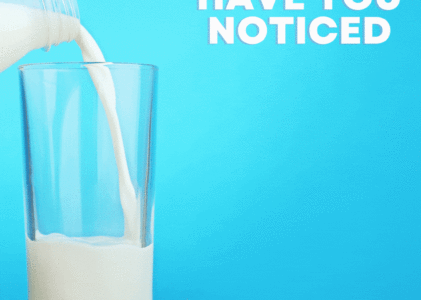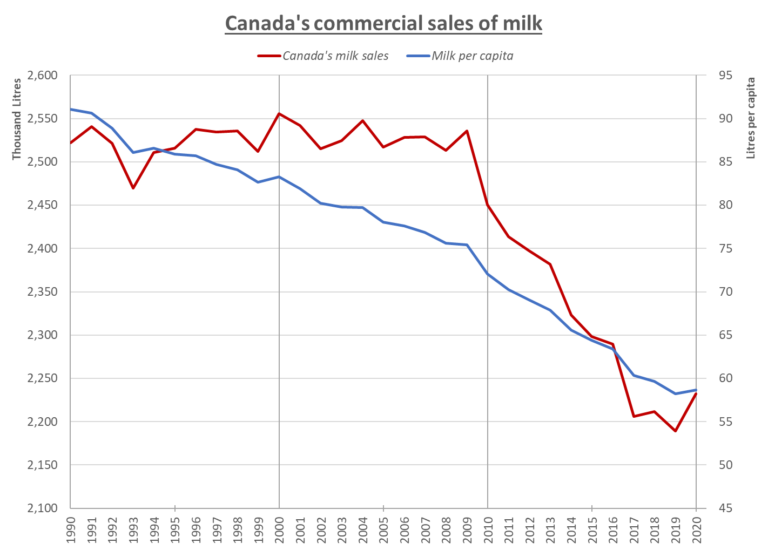My views & access to dairy have evolved
Having grown up in a small Saskatchewan community 45 minutes away from the city, I had a limited understanding of what dairy farming was. Of course, I knew about the standard milk products of skim to 3.25% milk, vicos, the creams (whipping, sour, and cheese) and marble cheese, but not much beyond this. This was in part because it was the 1990s and small town grocers could not supply every food product option, leaving me with only a small glimpse of what is in today’s dairy aisles. Much like my grandparents and parents must have thought as they witnessed food production and innovations change their local grocery stores, it is both exciting and at times it seems like gluttony to offer so many options. Of course, these changes to the dairy aisle or any other food aisle are not gluttonous, these changes are now inclusive and filling the various needs of all consumers. This week’s blog will look at a few examples of what has changed in the dairy aisles, why, and as a result, who is being served by these changes.
The fluid change of milk
The most obvious change in dairy products to me has been the expansion into alternative dairy options. Since 2010, milk sales have declined slowly, and on average milk sales per capita in Canada have declined by nearly 1.5 litres a year. That has resulted in a 9% drop in volume for fluid milk in Canada from 2010 to 2020. While milk consumption has declined, alternatives to milk have entered the market. In the 1950s, soymilk was the first dairy-free alternative to enter the US market, and since then, we have seen the aisle expand to almond, rice, coconut, oat, and even pea and pulse milk alternatives. These alternatives may seem like new products to many of us, but historically some of these ‘milks’ have been consumed by other cultures for centuries. Soymilk dates back to 1365 in Chinese text and on the European continent in the 14th-century almond milk was reportedly consumed during Lent. Originating from Southeast Asia, the coconut has been used as milk-like alternatives in cuisines and diets which now reach every nook and cranny of the globe.
There are multiple reasons we are seeing fluid milk aisles grow to include plant-based, non-animal based milk products. First, there are ethical concerns many consumers have about consuming milk from animals. While I enjoy milk products, I understand why others do not wish to consume or support the industry that utilizes the milk of other mammals. However, this is not the only reason we are seeing a switch to plant-based milk. There are also sustainability concerns, such as the emissions from dairy livestock and their feed production, land use, and water consumption needed to produce a litre of milk. I will not dive deeper on this topic, as each milk alternative has its pros and cons, and frankly, I do not wish to enter into this debate, and I do not wish to offend or take a side on such a debate. Lastly, as alluded to in the intro, these alternatives to dairy milk are cultural and personal. Just because you grew up drinking homogenized cow’s milk, doesn’t mean that everyone else around had the same experience. While the dairy aisle has grown to be inclusive of non-dairy milk, we have yet to see the expansion include the milk of goats, sheep, camel or buffalo (a third of milk production in the developed world come from these sources).
Migration of culture
Every culture around the world has its take on dairy, and as a result, each has similar, yet different dairy products. In Canada, we are slowly seeing the cultural influence in our dairy aisles. We see this in two ways, first, we have locally produced products that are now marketing dairy products made to taste like or in the style of international dairy products, and secondly, we have imported products. Let’s start by first examining the Canadian dairy market as simply as we can before diving into this further. Canada’s dairy is regulated by supply management, which means there are limitations on who can produce dairy in Canada, how much they can produce, as well as what can and cannot be imported into Canada as a dairy product. For those not in the industry, it might seem like a complicated system, but there are benefits and negatives, which I will leave up to you to research and determine for yourself.
Anyways, in this management system, there are also limitations as to what can be imported, which allows the Canadian dairy industry the opportunity to try to produce different cultures’ versions of dairy products. You can see this when you go to the yogurt section. Growing up I thought there were three forms of yogurt: plain (why bother), fruit on the bottom (stirring is too much of a hassle), and of course what I thought was the only yogurt to eat, stirred yogurt. As I got older, I remember seeing the commercial for Greek yogurt and thinking what’s this all about, isn’t yogurt just yogurt? The answer is no! Having learned from my great group of international friends, my views of what yogurt was, were so limited. Yes, Greek and Balkan yogurts are of course popular options here, but in recent years we have seen an explosion of options as other cultures ‘yogurt’ styles are introduced to the Canadian grocery store, which includes Kefir, Skyr from Iceland, Dahi from India, and Labneh which is a soft Middle Eastern cheese made from strained yogurt.
There is still plenty of room to be made in the dairy aisle as we see our grocers fill the demand for more diverse cultural dairy. Whether it’s our national dairy industry making the products, or imports expanding to include more international and specific dairy products, I can’t wait to try them all!
Milking the trends
Finally, and perhaps most effectively our dairy aisles have been changing due to information and marketing. As a child, every magazine I came across had a ‘got milk?’ ad of a big celebrity with a stupid milk moustache promoting the benefits of dairy. In Canada we have the blue cow label to reassure us the product is made from 100% Canadian milk. While dairy boards work hard to promote their products, it’s the marketing of brands and their products which has led the trends and helped to change our dairy. Cheese used to be sold in bricks, but now you can find it in all forms, shapes, and sizes to fit your needs, whether it’s shredded, stringed, individual spreadable packages, you name it, it’s available to meet your convenience. Many of us have been taught the importance of dairy since a young age, and how it benefits our health and bodies, so it’s no surprise that companies use this fact to help sell and promote dairy. Currently, in the marketing of ‘healthy’ milk products, we’re seeing products promoted as being low-sugar, low-fat, non-dairy dairy, and the newest trend of hybrid dairy. I must admit, I am a sucker for good marketing and from time to time I fall victim to my curiosity and the deliciousness of their marketing. If only they could start the retro trend of the Vi-Co, I would proudly line up each day at my cafeteria to buy my small carton of chocolate milk, as I refuse to drink a Milk 2 Go from a plastic bottle like a millennial.
I must admit, I am a sucker for good marketing and from time to time I fall victim to my curiosity and the deliciousness of their marketing. If only they could start the retro trend of the Vi-Co, I would proudly line up each day at my cafeteria to buy my small carton of chocolate milk, as I refuse to drink a Milk 2 Go from a plastic bottle like a millennial.
Dairy for all
It’s exciting to see our dairy aisle grow and change. With this expansion, we’re seeing dairy become inclusive for all! Whether it’s your preference for fluid milk, cultural representation and availability of dairy, or the convenience of dairy products, the change we see in our dairy aisles is an opportunity for us all. I hope the next time you’re at the grocer, you take the time to look at what is available, and maybe pick up a new product you haven’t tried before. In doing so you might just change your dairy habits for the future.



